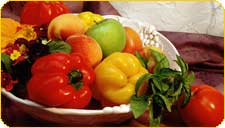Show Me a RecipeRed
Make these fruits and vegetables a regular part of your diet:
tomatoes, watermelon, cherries, cranberries, pomegranates, beets, red peppers, radishes, radicchio, red potatoes, rhubarb
These foods contain the important phytochemicals, lycopene and anthocyanins, which help promote:
- heart health
- urinary tract health
And, lower your risk of certain types of cancer. |
Show Me a Recipe
Blue-Purple
Make these fruits and vegetables a regular part of your diet:
blackberries, blueberries, black currants, dried plums, elderberries, purple figs, red grapes, plums, raisins, red cabbage, eggplant, purple peppers.
These foods contain the important phytochemicals, anthocyanins and phenolics, which help promote:
- heart health
- urinary tract health
- memory function
and, lower your risk of certain types of cancer. |
Show Me a Recipe Yellow-Orange
Make these fruits and vegetables a regular part of your diet:
apricots, cantaloupe, grapefruit, lemons, mangoes, nectarines, oranges, papayas, peaches, persimmons, pineapple, tangerines, squash, carrots, yellow peppers, pumpkin, rutabagas, sweet potatoes
These foods contain the important phytochemicals, carotenoids and flavonoids, which help promote:
- heart health
- vision health
- a healthy immune system
And, lower your risk of certain types of cancer. |
Show Me a RecipeYellow-Green
Make these fruits and vegetables a regular part of your diet:
avocados, green apples, green grapes, honeydew melon, kiwifruit, limes, green pears, artichokes, arugula, asparagus, broccoli, Brussels sprouts, cabbage, celery, cucumbers, endive, leafy greens, green onions, okra, peas, green peppers, snow peas, sugar snap peas, spinach, watercress, zucchini
These foods contain the important phytochemicals, lutein and indoles, which help promote:
- vision health
- strong bones and teeth
And, lower your risk of certain types of cancer.
|
Show Me a RecipeWhite-Green
Make these fruits and vegetables a regular part of your diet:
leeks, garlic, onions, chives, bananas, brown pears, dates, cauliflower, ginger, mushrooms, parsnips, shallots, turnips
These foods contain the important phytochemicals, allyl sulfides and allicin, which help promote: .
- hearth heath
- healthy cholesterol levels
and lower your risk of certain types of cancer . |
|

